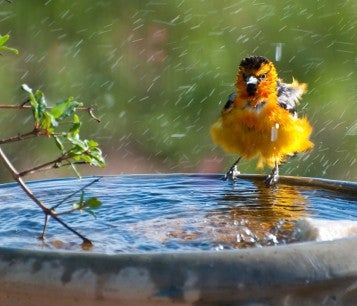Skunks, easily identifiable by their characteristic black and white striping, are infamous for producing a foul odor when frightened. Although a skunk’s spray is known mostly for its robust smell, it can also cause intense discomfort if it gets into a person or animal’s eyes.
People will go to extreme lengths to avoid getting sprayed by a skunk—even those who bill themselves as wildlife-control professionals. To stay outside the range of spray, these hired workers will sometimes kill skunks by injecting chemical solvents, such as acetone (aka nail polish remover), into the animal’s chest using a long pole syringe, likely causing a painful and stressful death. Skunks are at particular risk of inhumane killing methods, including treatment as horrific as drowning. As long as humane methods of deterrence and eviction are possible, there are ways to avoid being sprayed by skunks without causing extreme suffering.
Fortunately, these mild-mannered creatures rarely use this potent defense, and provide quite a few benefits to the areas they inhabit. In cases where eviction is necessary, a few mild harassment and deterrence techniques can help you humanely remove skunks while escaping smell-free.
Contents
No matter how big or small your outdoor space, you can create a haven for local wildlife. By providing basic needs like water, food and shelter, you can make a difference in your own backyard.

What should I do if I encounter a skunk?
It is more likely you will smell a skunk than see one. Persistent, faint musky smells under a building or woodpile may suggest that a skunk has taken up residence. You may find small, shallow holes in the lawn, similar to those made by squirrels, which are a result of a skunk foraging for grubs. Occasionally, you may even find plants knocked over or damage to the lower leaves or ears of ripening garden crops, including corn. You should look for these additional clues; foxes also have their own musky scent that may cause misidentification.
Occasional skunk sightings in a neighborhood are not a cause for alarm. Because skunks are generally easy-going, they will not intentionally bother people. In fact, skunks may benefit humans by eating many insects and rodents many regard as pests.
Warning signs
Skunks use their powerful defense only when they or their young are threatened and cannot escape. Even then, they give ample warning that should be heeded—stamping front feet, a raised tail, hissing, short forward charges and twisting their hind end around in your direction. Spotted skunks will even contort into a characteristic handstand, rump in the air with eyes still fixed on the threat. Move away slowly and quietly. By nature, dogs tend to ignore these warnings, so it is important they be restrained for their own good.
How do you get rid of skunks?
Because of the lingering odor, and fear of being sprayed, it may be hard for some people to tolerate skunks living under a deck or old shed. But skunks need shelter when they are most vulnerable (during the coldest parts of the winter and when raising young).
Skunks are nocturnal and non-aggressive, plus they play a beneficial role—all good reasons to just leave them alone until they have moved on of their own accord (which they readily do) or can safely be encouraged to leave an area where they are not wanted.
What attracts skunks to your yard?
Habitat modification
Skunks are opportunists at heart—they’re mainly attracted to low-hanging fruit like garbage and pet food left out at night, as well as convenient denning sites, such as wood and rock piles, elevated sheds, and openings under concrete slabs and porches and crawl spaces.
Preventive measures, such as removing attractants around houses, will decrease the likelihood of an unpleasant skunk encounter. This includes securing trash, covering window wells, feeding pets indoors, or if fed outdoors, removing food immediately after pets eat.
Skunks may also dig for grubs in the yard when wet soil conditions push insects close to the surface—their presence may be a sign of an overwatered lawn. Occasionally, however, a skunk may also wander into an open garage or shed, which is a compelling reason to secure all outbuildings.
Preventing denning (exclusion)
Exclusion techniques should be used proactively to prevent denning before an animal moves in. Any suspected skunk den should first be checked to determine if it has residents. This may be done by loosely filling the hole (or holes) with soil, leaves, straw, crumpled paper or similar material. If a skunk is present, the animal will easily push their way out overnight and reopen the hole.
If the plug remains undisturbed for two or three nights, it is safe to assume that the hole is unoccupied and can be filled. In the winter, skunks may remain inactive for longer periods, so provide them with a bit more time to disturb the plug before blocking the den entrance. Permanently exclude skunks (and other den-seeking creatures) with an L-shaped footer of welded wire or similar barriers.
If a skunk is using the den, either harassment or eviction using a one-way door system is recommended. When evicting skunks, be sure that dependent young are not present. When in doubt, assume they are and use the door only after they start following their mother to forage. Leave the door in place from two or three nights to a week to be sure the skunk has left.
Should I harass a skunk?
When it is safe to displace skunks, mild harassment can be very effective. This can be as simple as loosely repacking the den hole with leaves or straw or other material to see if the skunk gets the message and moves elsewhere. If they require more persuading, adding light and noise to make an dark and quiet denning space unattractive may help as well. Make sure the skunk is not close by before setting up the disturbances.
Can I use repellants?
Repellants may also be effective in skunk deterrence. Mild repellents, such as used kitty litter, can be placed near or inside the den to one side so the skunk has to pass them to get out; commercial or homemade capsaicin or castor oil repellents may also be tried.
Avoid buying skunk deterrents that are based on predator urine; these products are created under inhumane conditions, and are not necessary to repel skunks effectively.
Stronger products, such as the powerful capsaicin-based “hot sauces,” are often unnecessary. In the case that they are used, they must be treated with extreme care due to the consequences for people, and animals who may inadvertently come into contact with them.
What if I find a skunk in my garage?
Skunks who have wandered into a garage can simply be allowed to wander back out by making sure the door is open before dusk. Skunks are nocturnally active, so opening the door at dusk and closing it later in the evening is likely to be a solution to this problem.
It is important to make sure the skunk has not been coming and going for long enough to have established a den and given birth, and that any accessible foods (bags of bird seed, for example) have been moved and secured in tightly sealed containers.
Removing a skunk from a window well
It is not uncommon for skunks, with their climbing abilities and weak eyesight, to become trapped in a window well or similarly deep pit. If this happens, provide a means of escape.
Place a rough board (or one with cleats, carpet, toweling, chicken wire or other material to give the animal traction) that is long enough to serve as a ramp out of the well. Skunks are poor climbers, so the board should lean no steeper than a 45-degree angle. Trying to stay out of sight of the skunk, slowly and carefully lower the board. If possible, a second person with a vantage point high enough to see the skunk (perhaps from an upstairs window) can warn of any signs of agitation.
Another method of placing the board is to tie it to the end of a long pole and lower it by holding the opposite end of the pole. Once the board is placed, keep people and pets away from the area until nightfall, when the skunk should leave.
If the skunk cannot climb out due to the well’s depth or steepness, the Connecticut Wildlife Rehabilitators Association recommends a technique that involves a garbage can and smelly cheese. Place the cheese at the bottom of the can and lower it on its side with the open end facing the skunk. Once the skunk enters and begins to dine, carefully tilt the can up a bit, raising it elevator-style out of the window well, then gently tip it on its side again so the skunk can amble out.
How can I neutralize skunk odors?
The traditional remedy for removing the smell of skunk spray is a tomato juice bath. However, tomato juice, in conjunction with vinegar, only serves to reduce the stench, as it doesn’t neutralize the molecules that make skunk spray particularly pungent. Here’s a particularly effective remedy that’s safe for dogs and cats, as well as humans:
Mix together:
- 1 quart of 3-% hydrogen peroxide
- 1/4 cup baking soda
- 1 teaspoon liquid dishwashing soap
Wearing rubber gloves, wash with this solution immediately after the spraying occurs. DO NOT get the solution in eyes. (If you don't have peroxide, baking soda, and liquid soap on hand, use vinegar diluted with water.)
Caution: Do NOT store this mixture or make it ahead of time, as the mixture could explode if left in a bottle.
Rub the mixture all over and scrub deep to neutralize the odor. However, if you’re washing your dog or cat, don’t leave the mixture on longer than you have to as peroxide can bleach fur. Rinse the solution off thoroughly, and the smell should be gone.
What to Do When a Skunk Sprays Your Dog
Do skunks have rabies?
The skunk is one of four wild animals (including the fox, raccoon and bat) considered to be primary carriers of the rabies virus and is, therefore, classified as a rabies vector species. Skunks have also been known to carry leptospirosis.
Even though skunks are mostly active at night, they sometimes look for food by day—particularly in the spring, when they have young and may be extra hungry. Don’t be concerned if you see an adult skunk in the daytime unless they are also showing abnormal behaviors:
- Limb paralysis
- Circling
- Boldness or unprovoked aggression
- Disorientation, staggering
- Uncharacteristic tameness
Don’t approach the skunk yourself. Call your local animal control officer, wildlife rehabilitator, health department, or police department for assistance.

